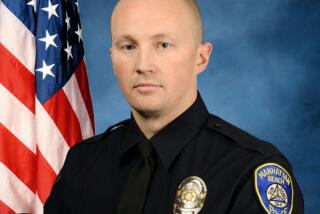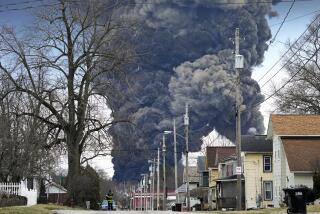Drugs Found in Engineer in Train Crash
- Share via
CORONA — An engineer involved in last November’s freight train crash that left four crew members dead tested positive for two powerful stimulants, according to laboratory results released Friday by the National Transportation Safety Board.
Federal investigators said they will now attempt to determine what impact the stimulants could have had on the performance of the 50-year-old engineer, James A. Dawson of San Bernardino County.
Dawson, an employee of the Atchison, Topeka & Santa Fe Railway Co. since 1971, tested positive for methamphetamine and amphetamine, according to the laboratory analysis performed for the federal safety board.
Dawson, still healing from injuries to his legs and ankles, could not be reached for comment Friday.
Cathy Westphal, a spokeswoman for Santa Fe in Chicago, said that Dawson has been suspended without pay, pending completion of a “formal investigation” he requested that is to be conducted by company and union officials.
“He is being held out of service,” Westphal said, adding that Dawson has no history of drug use or any other disciplinary problems.
Michael J. Martino, the NTSB’s investigator in charge of the Corona crash, said it is too early to determine whether Dawson’s condition may have had a bearing on the accident.
“There will be some credence given to it, insofar as determining whether it would have impaired him in his duties,” Martino said from Washington.
Martino also said that investigators will conduct a computerized “simulation” of the accident on Monday in Chicago to assess the significance of Dawson’s possible impairment.
Dawson’s train was headed east, to Chicago when it was struck at 4:10 a.m. on Nov. 7 by a westbound freight train that investigators believe left a parallel strip of siding and veered onto the center track. The accident occurred in an industrial section of Corona, 50 miles east of downtown Los Angeles.
Investigators said Friday that they still believed the westbound freight train caused the accident and that mechanical malfunctioning has been virtually ruled out as a factor.
As for investigators’ belief that the westbound train erred by coming back onto the track, instead of stopping on the siding, one commented that the westbound train “didn’t honor the signal system.”
“But if there’s a possibility that it could have been prevented by either train, regardless of who was at fault, we want to know that. . . . We’ll pursue every avenue to see if it (Dawson’s alleged drug use) would have been germane to the accident.”
Alan Pollock, a spokesman for the safety board, declined to assess what effect on Dawson’s performance the stimulants may have had.
Dr. Stephen C. Bondy, a professor of toxicology at UC Irvine, described the two substances detected in Dawson as “powerful . . . addictive stimulants.” Methamphetamine, he said, is not prescribed by physicians.
Bondy said in an interview that the concentrations of the stimulants found in Dawson’s urine were “very low.” However, Bondy said that the timing of when Dawson was tested and when he ingested the drugs would tell investigators more definitively what effect the substances may have had.
“There’s no doubt in my mind that it’s a potential contributing factor” to the accident, Bondy said, adding: “If you take (methamphetamine) long enough, you will have psychosis, paranoid condition.”
The crash last November killed all three members of the westbound train and the brakeman on the eastbound train. Killed were Virginia C. Hartzell, 29, of Baldwin Park; Gary R. Ledoux, 35, of Highland, Calif.; James S. Wakefield, 55, of Fontana; and Ronald E. Westervelt, 51, of San Bernardino.
More to Read
Sign up for Essential California
The most important California stories and recommendations in your inbox every morning.
You may occasionally receive promotional content from the Los Angeles Times.














